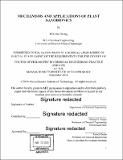Mechanisms and applications of plant nanobionics
Author(s)
Wong, Min Hao.
Download1103917145-MIT.pdf (15.86Mb)
Other Contributors
Massachusetts Institute of Technology. Department of Chemical Engineering.
Advisor
Michael S. Strano.
Terms of use
Metadata
Show full item recordAbstract
Plant Nanobionics seeks to use rationally designed nanoparticles to interface directly with plant cells and organelles to augment plant functions, as well as to introduce non-native functionalities. The broader vision is to create a wide array of wild-type plants, not genetically limited to specific species, capable of imaging objects in their environment, self powering themselves as light sources, IR communication devices, and also function as self-powered ground water sensors. Plants are uniquely suited to perform such roles due to their ability to generate energy from sunlight and photosynthesis. They are also in constant fluidic exchange with the environment, both in gaseous exchange via the stomata, as well as in their continual uptake of water and mineral salts from the ground. Furthermore, plants have a negative carbon footprint and contribute aesthetically to our living environment. In this thesis, we first study the trafficking and uptake of nanoparticles into plant tissues, cells and organelles. We focus our work particularly on the chloroplast, which is a plant organelle organized for photosynthesis and self-repair of photosynthetic proteins. Many important plant functions, such as carbon dioxide reduction or energy generation is carried out within the chloroplast - a plant organelle that appears greatly under explored as an engineering material. We examine the subcellular uptake and kinetic trapping of a wide range of nanoparticles for the first time, using the plant chloroplast as a model system, but validated in vivo in living plants. Confocal visible and near-infrared fluorescent microscopy and single particle tracking of gold-cysteine-AF405 (GNPCys- AF405), streptavidin-quantum dot (SA-QD), dextran and poly(acrylic acid) nanoceria, and various polymer-wrapped single-walled carbon nanotubes (SWCNTs), including lipid-PEGSWCNT, chitosan-SWCNT and 30-base (dAdT) sequence of ssDNA (AT) 15 wrapped SWCNTs (hereafter referred to as ss(AT) 15-SWCNT), are used to demonstrate that particle size and the magnitude, but not the sign, of the zeta potential are key in determining whether a particle is spontaneously and kinetically trapped within the organelle, despite the negative zeta potential of the envelope. We develop a mathematical model of this lipid exchange envelope and penetration (LEEP) mechanism, which agrees well with observations of this size and zeta potential dependence. The theory predicts a critical particle size below which the mechanism fails at all zeta potentials, explaining why nanoparticles are critical for this process. Lastly, we then extend this study to consider whole protoplast, which are isolated plant cells without cellulosic walls. Taken collectively, the understanding of nanoparticle trafficking and uptake would enable the design of nanomaterials for gene delivery and sensing, augmented plant functions, or the introduction of non-native functionalities into plants. We then extend these design principles to demonstrate living spinach plants (Spinacia oleracea) as new materials and functional devices that serve as self-powered auto-samplers and pre-concentrators of nitroaromatics within ambient groundwater, detectors of the organic molecules contained therein, and infrared (IR) communication platforms that can send this information to a user's smart phone. The design employs a pair of near infrared (nIR) fluorescent nanosensors embedded within the plant leaf mesophyll. One nanosensor is engineered through the Corona Phase Molecular Recognition (CoPhMoRe) technique using single walled carbon nanotubes (SWCNTs) conjugated to the peptide Bombolitin II to recognize nitroaromatics via IR fluorescent emission at > 1100 nm with a response time of 5-15 mins after introducing 400 [mu]M of picric acid to the roots. The second IR channel is a polyvinyl alcohol (PVA) functionalized SWCNT that acts as an invariant reference signal. As contaminant nitroaromatics or dopamine in solution are transported up the roots and stem into the leaf tissues, they accumulate in the mesophyll where the pair of SWCNT sensors are embedded. This results in relative changes in the intensity of SWCNT emission, with a response rate that is mathematically described using a whole plant residence time model. The real-time monitoring of embedded SWCNT sensors also allows residence times in the roots, stems and leaves to be estimated, calculated to be 8.3 min (combined residence times of root and stem) and 1.9 min/mm leaf, respectively. We further show that this system is generalizable to the detection of other analytes, such as dopamine which is known to effect physiological changes in plants. These results demonstrate the ability of living, wild-type plants to function as chemical monitors of groundwater and communication devices to external electronics at standoff distances. Overall, the mechanistic understanding of nanoparticle trafficking within plant tissues, cells and organelles, as well as the development of new nanobionic methods for nanomaterial-plant interactions will enable the elucidation of basic plant functions and the creation of self-powered, net zero-carbon plant based devices.
Description
Thesis: Ph. D. in Chemical Engineering Practice, Massachusetts Institute of Technology, Department of Chemical Engineering, 2018 Cataloged from PDF version of thesis. Includes bibliographical references (pages 128-141).
Date issued
2018Department
Massachusetts Institute of Technology. Department of Chemical EngineeringPublisher
Massachusetts Institute of Technology
Keywords
Chemical Engineering.